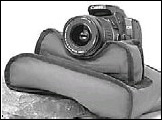Sun
Archive for February, 2007
Floorings that are eco-considerate
Saturday, February 24th, 2007Kim Davis
Sun
Think that going green means fewer options? Think again when it comes to flooring. From carpet, wood, bamboo and cork to linoleum, rubber, glass and stone, innovative manufacturers are offering a growing array of high-performance, competitively priced floors that are eco-considerate as well as healthier for inhabitants.
Here are a few things to keep in mind when looking for eco-savvy treads, as well as a brief review of some of the products you might find under foot.
CHECKING FOR CREDENTIALS
Like all products that purport to be green, it can be difficult to discern which floors walk a truly sustainable walk. Third-party certification systems such as GREENGUARD, the Forest Stewardship Council (FSC), and Canada’s Environmental Choice Program (EcoLogo) can help you identify products that meet higher environmental and health standards.
For example, EcoLogo promotes products that, in addition to meeting or exceeding accepted industry performance standards, aggressively use recycled content, reduce undesirable chemicals, and conserve resources.
WHAT LIES BENEATH
Environmental beauty may prove little more than skin-deep if toxic binders, glues and finishes that release volatile organic compounds (VOCs) gaseously, or contain high levels of known carcinogens like formaldehyde, are used to manufacture, finish, or maintain your floor.
Select products that utilize water-based, solvent free adhesives and finishes made from natural ingredients, which provide protection and durability without a plastic shine or noxious fumes.
When it comes to carpet, be sure to ask about the underlay, product backings, and the pad or cushion.
In addition to better adhesives, some of today’s carpet backings are made with recycled content (including car windshields!), and/or with natural fibers such as jute and natural rubber.
B.C.’S HOT NEW WEED?
Used for centuries to make everything from spoons to buildings, bamboo flooring is quickly becoming one of B.C.’s hot design trends.
Solid and engineered bamboo flooring products are created by slicing round bamboo shoots into strips, and boiling and treating them with a preservative.
The strips are then dried and laminated into solid boards and milled into standard strip flooring profiles.
Valued for its purported hardness, and resistance to water, mildew and insects, bamboo is available naturally and in a range of pre-finished colours. It can also accept many different stains and be installed, sanded and refinished like hardwood.
Environmental Building News notes that “environmentally, it’s hard to argue with a wood substitute that matures in three years, regenerates without need for replanting, and requires minimal fertilization or pesticides.
However, as harvesting and manufacturing practices can vary widely, and there is no official grading system like FSC for bamboo, consumers should consider inquiring about the source of any product they purchase.
Reports on the hardness of bamboo, an attribute widely touted by vendors, range from as soft as fir to harder than oak.
It typically comes pre-finished in planks, including a floating floor type that clicks together with tongue and groove construction negating the need for glue or nails.
TOAST OF THE TOWN
Harvested from the outer bark of the cork oak tree, cork is waterproof and airtight which makes it resistant to moisture and decay.
The natural elasticity of cork makes it especially comfortable underfoot, as well as a good acoustic insulator.
It is durable, and contrary to what one might think, recovers well from marks left by furniture or high heels. Cork floors are also hypoallergenic, fire-resistant, and naturally resistant to insects.
Recent news regarding the wine industry’s shortage of corks has some people wondering how cork can be considered sustainable.
According to the Environmental Home Center in Seattle, however, while the surging popularity of wine has resulted in a shortage of natural wine corks, the “waste” cork that derives from the making of corks, and which is used to create is much cork flooring is readily available.
Cork comes pre-finished, in tiles (which must be glued down), floating plank systems and most recently small mosaic tiles.
It can be found in a range of neutral tones and styles–from taupe and corkboard-like, to dark chocolate and an almost leather look.
A RECIPE FOR DURABILITY
So durable that ferry boats reportedly use it, linoleum is a completely biodegradable material made from a mix of all-natural materials such as linseed oil, wood flour, rosin, jute and limestone. Linoleum is inherently anti-bacterial, hypoallergenic and antistatic. The latter of which repels dust and dirt making, which makes it easy to clean without the use of soaps and very little water. Sold in rolls, tiles, and now floating planks, linoleum comes in a wide range of colours and patterns.
SOY BETWEEN MY TOES
No longer limited to simply colour and pile height, carpets can now be found in a wide range of natural and recycled materials. From recycled bicycle inner tubes, inspired by the sheer number of bicycles in India, to soy fibre that offers the sumptuousness of cashmere, velvet and alpaca all rolled together (for a comparably luxurious price). Sisal carpets, made from the rope-like fibers of the agave cactus, like wool are naturally flame retardant, anti-static and sound absorbent.
YET TO BE FLOORED
To learn about more flooring options, including more traditional grains like wood, check out woodfloorrg.com on the Internet.
A great resource for nearly everything you would want to know about eco-friendly wood, including a helpful product selector, is edcmag.com on the Internet.
© The Vancouver Sun 2007






